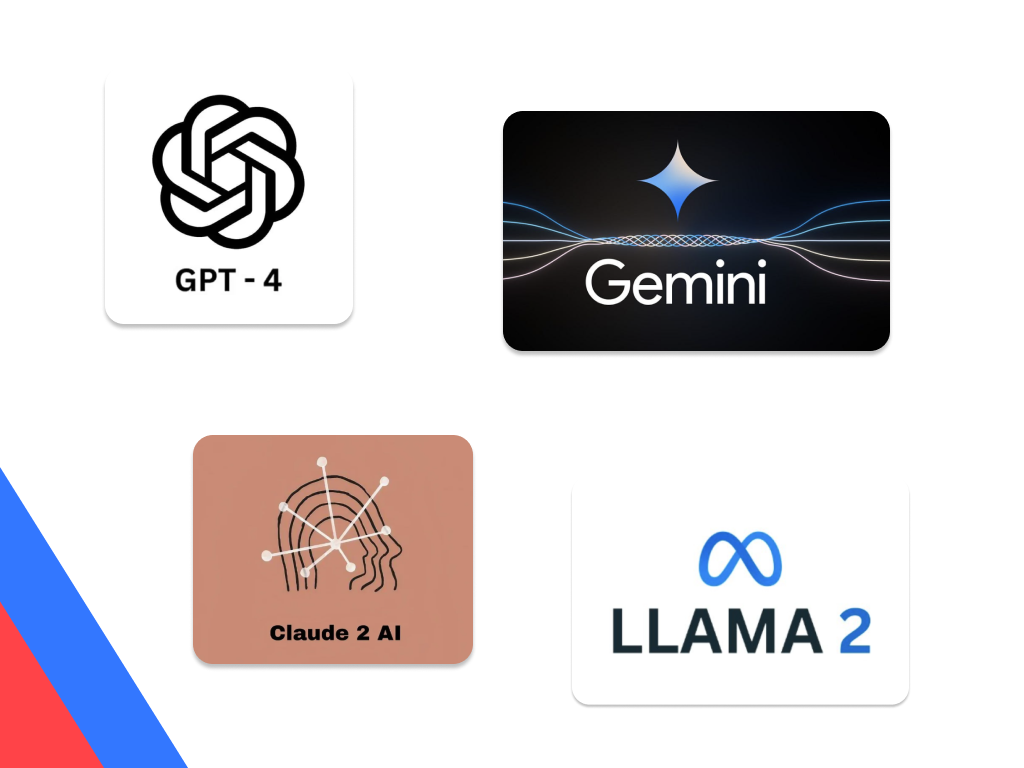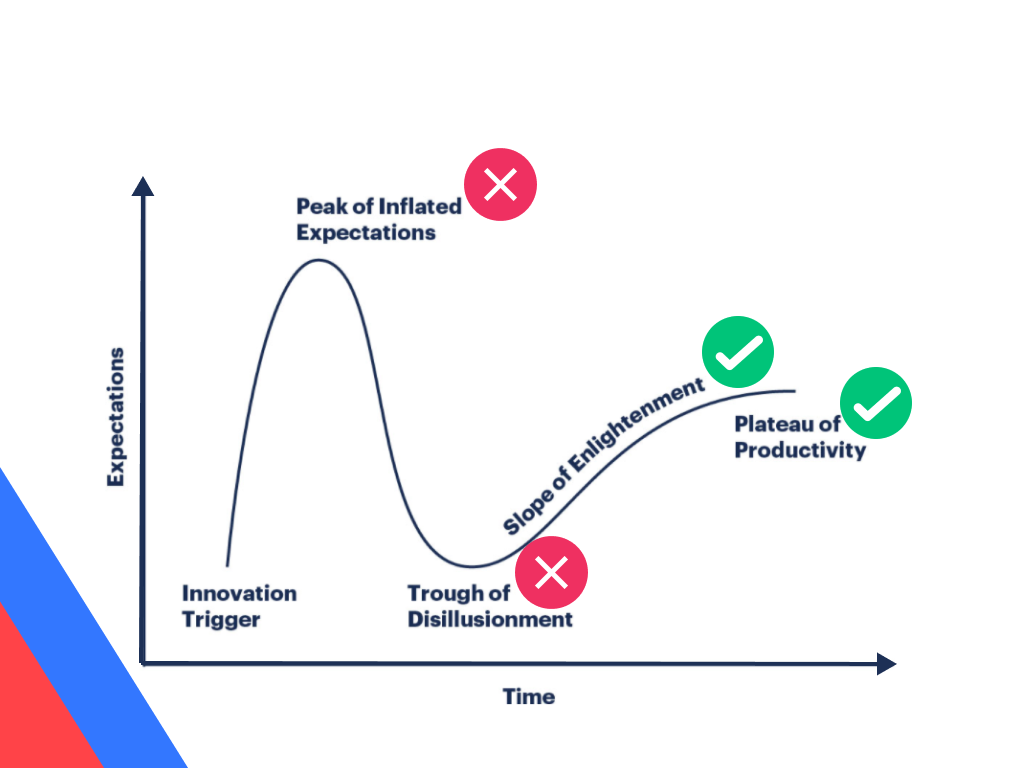
How to pursue steady progress and
how to see through the hype.
05/2024
Imagine your company is like a professional basketball team during a timeout in the NBA finals. Have you ever listened to the speeches that the best coaches give in those moments? Surprisingly, it will not be a speech about complex, secretive strategies. Instead, they often revert to straightforward, fundamental advice such as “Keep the ball moving!” or “Shoot, if you see an opportunity!”. Take a look at this example, if you don’t believe us.
In such high pressure, nervous moments, they bring the attention of the team back to the basics, back to the simple truths that everyone understands. Similarly, in the fast-paced and high-pressure world of artificial intelligence (AI), with all of its uncertainties, companies that aren’t specialized in AI might feel overwhelmed and lose their way.
In such situations, it’s wise to filter out the noise, focus on the basics, and rely on common sense. This approach helps clear the path forward and ensures steady progress amidst the hype and complexity of AI technologies. At ValueFlow, we’re fans of this common sense approach and want to describe it here in more detail.
Common sense for AI
What does common sense look like when it comes to integrating AI into your business? It often means sticking to principles that have stood the test of time because what has been true for a long time is likely to remain true for the next few years as well. When approaching AI, avoid getting caught up in its politicization. Although AI will undoubtedly influence society’s evolution over the next decade, treating it as a polarizing issue can be counterproductive for a business. Instead, consider AI from a practical standpoint: how can it enhance your company’s productivity? What might the consequences be if your competitors adopt AI and triple their productivity while you lag behind?
The key is to start with manageable, incremental steps. Focus on refining existing processes before diving into new AI capabilities. This approach minimizes disruption and allows for steady, manageable improvements. In essence, don’t let the hype around AI distract you from the basics. First, enhance what you already do well, then explore how AI can further support and expand those capabilities. Now, let’s break down this common sense approach into actionable do’s and don’ts.
Do's
Learn about AI (on a conceptual, superficial level):
Before diving into AI, it’s usefule to build some level of understanding. Start by learning about AI at a conceptual level — there’s no need for non-IT personell to learn about technical details, but there is great value in understanding the rough functioning of these models. There are many great and simple-to-understand training resources out there. (e.g. Google’s first chapters on AI, or several YouTube videos)
Formulate your tasks / problems / use cases:
Next, take a close look at the tasks, problems, or use cases your company faces. Don’t yet think about how AI can solve or support them. At this point, you are in the “problem space” and only desire to describe the task as precise as possible. You might know the phrase “a problem well-defined, is a problem half-solved” – which will prove quite true for tasks that you will augment through AI workflows.
Prepare your (internal & external) data:
Focus on your data — it’s the fuel for AI. Gather your data (this can be important documents, notes, reports, tables, learnings, protocols), ensure it’s clean, of high quality, and well-labeled (i.e. such that a new colleague or also an AI system has the chance of understanding it). This data can be internal or external. Consider what types of information or data you frequently use in your job, as these will likely be important when integrating AI.
Experiment with tools & solutions:
Once you’re set with a solid base of knowledge and data, shift into experimentation mode. Test out various tools and opt for a simple, cost-effective solution to start. Prioritize the tasks you want AI to enhance, beginning with the most critical ones. Reflect on the core value your company creates; ask yourself if AI can support or enhance this value. This thought process can lead you to valuable AI applications for your business.
Reserve some time in your calendar to make AI progress:
Finally, to make the most of AI, block out regular times in your calendar dedicated to crafting solutions for your tasks. Use this time to evaluate what’s working and what isn’t — for example, spending an hour every Friday and reviewing your progress. This disciplined approach will help you steadily integrate AI into your operations, making it a natural part of your workflow.
Dont's
Don’t monitor the flood of daily released new AI tools:
Incorporating AI into your business should be a measured, strategic process. Avoid jumping onto the bandwagon of every new tool that claims to be a game-changer; rather, concentrate on developing your own resources and monitoring your own progress. This deliberate focus helps avoid the distraction of constant breakthrough announcements in the AI field.
Don’t make large investments at the beginning:
Also, don’t overcomplicate the introduction of AI into your operations. Instead of making hefty upfront investments, adopt a lean approach that allows for flexibility and easy adjustments as you learn and grow.
Don’t expect a miracle:
Set realistic expectations: AI is unlikely to either devastate your business or cause it to skyrocket within a year. The true impact of AI will unfold over the next – say – 5 to 10 years. By maintaining this practical perspective, you can implement AI in a way that is both effective and sensible, ensuring steady progress rather than sudden company turn-arounds.
Don’t panic:
Your company is not in a uniquely difficult situation: every company faces the same uncertainties. The fact that you’re currently reading this article means that you’re already engaging with the topic, and that’s an excellent start. AI integration at the application level isn’t rocket science, and with consistent and conscious effort, you’ll begin to see significant benefits. Far from causing panic, you’ll likely notice many positive effects of AI support, such as more time for crucial aspects of your work, increased motivation, and reduced repetitive stress.
Conclusion
In conclusion, the do’s and don’ts outlined in this article demonstrate that AI is not a mystical thing but rather a technology that requires a practical and informed step-by-step approach. Like any new topic, AI involves a learning curve and demands some adjustment and familiarity. However, by adhering to a few fundamental principles, just like a basketball coach’s guidance during a brief timeout, you can navigate the complexities of AI with confidence.
Embrace the simplicity of these core truths, and you’ll find that integrating AI into your business can be straightforward and will be quite beneficial.
May 2024 | ValueFlow team
Reach out with comments or suggestions:
comment@valueflow.ai




